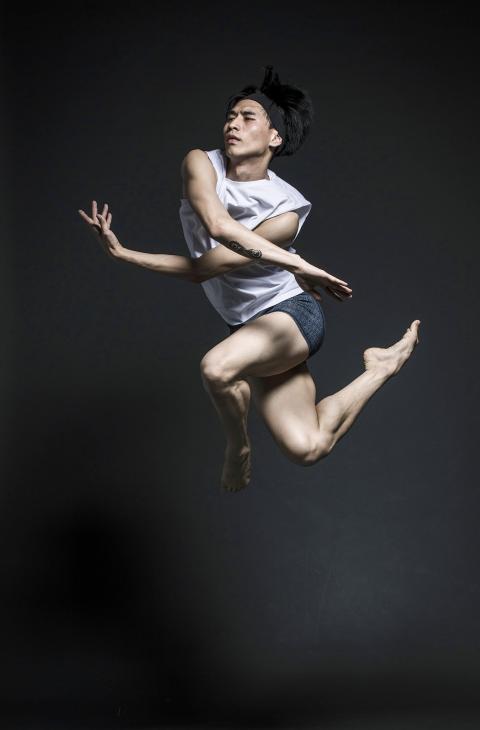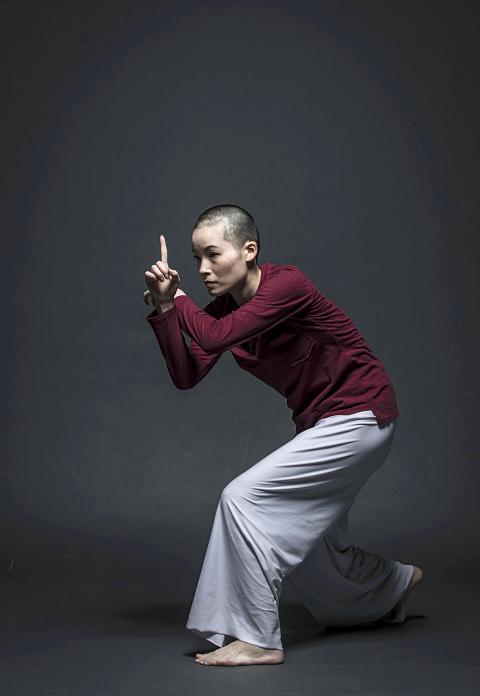The Meimage Dance Company’s New Choreographer Project (鈕扣New Choreographer計畫) show at Taipei’s Huashan 1914 Creative Park last weekend once again demonstrated the power and allure of one of Taiwan’s premier exports — its professional dancers and choreographers.
The project’s seventh edition featured Tung Po-lin (董柏霖), a dancer with London-based Company Wayne McGregor; Liu I-ling (劉奕伶), who is with the New York City-based Bill T. Jones/Arnie Zane Company and Tu Lee-yuan from GoteborgsOperans Danskompani in Sweden.
The program opened with Tung’s reflective solo, Why does he want to leave? (為甚麼他要離開), which began with him seated on the floor at the front of the Umay Theater’s small stage singing and playing guitar, before a short video projected onto the rear wall started.

Photo: Courtesy of Terry Lin
The rather quiet and unconventional beginning to the dance belied the dynamism of Tung’s choreography, which made full use of his arms, precise footwork and ballet training.
It was interesting to reflect how after just a year of working with McGregor, the British choreographer’s penchant for sharply articulated legs, feet and arms appears to be rubbing off on Tung.
Liu’s piece, Gung (更), also saw her singing a bit, but her years in New York, straddling different cultures, both societal and dance, made for a work that began as soft and funny, even wistful, before turning into a provocative dance of assertive empowerment.

Photo: Courtesy of Terry Lin
The transformation was highlighted by the costume change from a very girlish pink dress (with matching shorts), red belt and strappy red sandals that the shaven-headed Liu wore before discarding them in favor of a crimson jersey top and grey sweatpants.
Jones’ sometimes confrontations story-telling style was also reflected in Liu’s piece.
The standout on the program was the final work, Tu’s It Takes Two to Tango, which he performed with one of his Goteborg colleagues, Jan Spotak, a Slovakian-born dancer/choreographer.
There was no singing, at least by the two men, but a lot of comedic and physical interplay based on the pair’s height differential, along with a tea cup and saucer, plus some very fine dancing.
Tu set his piece to a score that ranged from Caetano Veloso’s Cucurrucucu Paloma to Woodkid’s Run Boy Run and Arcade Fire’s Song on the Beach.
It Takes Two to Tango opens with Tu and Spotak kneeling facing one another, one arm raised across their chest and pressed against the other’s, a cup and saucer balanced atop the two limbs.
Their torsos swayed and bodies circled one another without ever losing contact or the cup and saucer, before they effortlessly rose, still locked to one another and the porcelain.
Initially they always stayed in close contact, with Spotak lifting Tu, raising him over his shoulders and around his body, dragging him around or carrying him in his arms like fallen angel.
The pace shifted from slow and relaxed to fast and fluid and Tu also had a chance to manipulate his taller partner.
The alternating dynamics between the pair, their physical exuberance and the playfulness of the choreography made for a very engaging piece and a great introduction to Tu’s works. I would like to see more.
The New Choreographer Project show will be performed in Yilan County tomorrow and Saturday at the Chung Hsing Cultural Creative Park (中興文化創意園區) in Wujie Township (五結). The shows start at 7:30pm and are free.
Last weekend also proved to be a good one for Taiwanese choreographer Benson Tsai (蔡博丞) and his B.DANCE (丞舞製作團隊) troupe, with Tsai scoring yet another win in an international choreographic competition, this time in Switzerland.
First prize at the Tanz-Plattform Bern was awarded to Tsai’s Innermost and L‘aveuglement by the Belgian-based duo of Victor Launay and Sara Olmo, who are collectively known as Les Vikings.
The first place win comes with a commission to create a work about by Albert Einstein for the Dance Company Konzert Theater Bern to premiere in May next year.
The Bern jury praised Innermost’s “colorful, exciting and also humorous choreography.”

Last week, the the National Immigration Agency (NIA) told the legislature that more than 10,000 naturalized Taiwanese citizens from the People’s Republic of China (PRC) risked having their citizenship revoked if they failed to provide proof that they had renounced their Chinese household registration within the next three months. Renunciation is required under the Act Governing Relations Between the People of the Taiwan Area and the Mainland Area (臺灣地區與大陸地區人民關係條例), as amended in 2004, though it was only a legal requirement after 2000. Prior to that, it had been only an administrative requirement since the Nationality Act (國籍法) was established in

Three big changes have transformed the landscape of Taiwan’s local patronage factions: Increasing Democratic Progressive Party (DPP) involvement, rising new factions and the Chinese Nationalist Party’s (KMT) significantly weakened control. GREEN FACTIONS It is said that “south of the Zhuoshui River (濁水溪), there is no blue-green divide,” meaning that from Yunlin County south there is no difference between KMT and DPP politicians. This is not always true, but there is more than a grain of truth to it. Traditionally, DPP factions are viewed as national entities, with their primary function to secure plum positions in the party and government. This is not unusual

The other day, a friend decided to playfully name our individual roles within the group: planner, emotional support, and so on. I was the fault-finder — or, as she put it, “the grumpy teenager” — who points out problems, but doesn’t suggest alternatives. She was only kidding around, but she struck at an insecurity I have: that I’m unacceptably, intolerably negative. My first instinct is to stress-test ideas for potential flaws. This critical tendency serves me well professionally, and feels true to who I am. If I don’t enjoy a film, for example, I don’t swallow my opinion. But I sometimes worry

US President Donald Trump’s bid to take back control of the Panama Canal has put his counterpart Jose Raul Mulino in a difficult position and revived fears in the Central American country that US military bases will return. After Trump vowed to reclaim the interoceanic waterway from Chinese influence, US Defense Secretary Pete Hegseth signed an agreement with the Mulino administration last week for the US to deploy troops in areas adjacent to the canal. For more than two decades, after handing over control of the strategically vital waterway to Panama in 1999 and dismantling the bases that protected it, Washington has